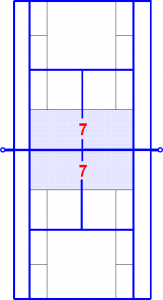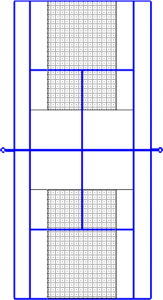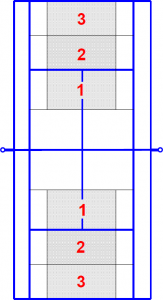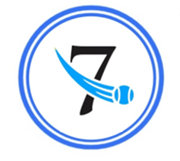7 Shot Tennis: See the point
7 Shot Tennis is about what you see when you watch a point; it’s about what you see or feel when you play or practice points; it’s about how you talk about how points and games and matches are played. As a game plan for player development, 7ST focuses on the use of mental representation, purposeful practice and deliberate practice. The “seven shots” refer to your target areas; there are five tactical situations which are where you are hitting from. Serve targets and return targets are also essential to a player’s performance. With a clear understanding of the elements of defending, neutralizing and offensive positions and patterns, both player and coach can collaborate on a path to higher levels of performance.
In this edition of The Point I’ll discuss mental representations and what you should begin seeing when you look across the net at your opponent’s court. You will also get an understanding about how target areas 1, 2 and 3 evolved. There will even be a question to test your understanding of the court in general.
Mental Representations
Consider the following list: The Eiffel Tower, The Statue of Liberty, The Great Pyramids, The Sphinx, a tennis court. My guess is most of you reading this will immediately see a picture of each of these in your mind. These pictures are mental representations; they’re very important. If you’re watching a movie and you see a scene with the Eiffel Tower, you’d know the scene takes place in Paris. You’d be in New York City if you saw the Statue of Liberty, or in Egypt if you saw the Sphinx. Of course, you may just be lost somewhere along the Las Vegas strip, but you get the idea.
As for the tennis court, what do you see when you look across the net?
Here’s a question from the Level 1 Standardized Tennis Match Charting certification: The service line on a tennis court is:
- Farther from the net than it is from the baseline
- Midway between the net and the baseline
- Closer to the net than it is to the baseline
There are several questions for Level 1 certification that are designed to test for general tennis knowledge. You’d be surprised at some of the experienced tennis people who stumble over this question. Even if your answer was (a), did you find yourself reading the question a few times to make sure you got it right? If you answered (b), take a minute or two to take another look at a court. If you answered (c), you’ve probably figured out by now that you missed it. The good news is, this is the kind of question that once you realize you missed it, you will always remember the right answer. In other words, you learned something you didn’t know or didn’t see before. And you will retain it. It’s questions like this that are used throughout each certification process.
Mental Representation: The Court
If you’re looking across the net at your opponent’s court, picture a line midway between the net and the service line that runs from singles sideline to singles sideline. The area that’s closer to the net is target area 7. If you absolutely must hit a dropshot, would you rather the ball bounce (a) closer to the net, or (b) closer to the service line? This is an either/or question.
Another way to put this is: Are your chances of winning the point better with (a) or (b)? Test yourself on this the next time you play or practice.

Starting at the boundary line of target area 7, imagine a line inside each singles sideline that creates an area the same width as a doubles alley all the way to each baseline. Think of these two areas as the singles alleys. We will look at the singles alleys later but, for now focus on the area that’s inside each singles alley from the 7 to the baseline. This is a wide corridor running up the center area of the court. It’s where most players learn, practice and play most of their tennis lives.

Mental Representation: The Center Corridor, Targets 1, 2 and 3
As someone who tried teaching tennis for 37 years, I’m fascinated by watching people learn. Something I learned from watching two UTR Level 1* (see below the four milestones to becoming a Level 1 play) players in a tournament match is they hit most of their shots into an area just inside the service line and pretty much close to the center service line. [Target Area 1]
Very quickly the players develop a good sense of a high margin for error. For years beginners have been chastised for standing in “no man’s land.” It makes total sense, though: in their world the next ball is going to be short. But, as the players gain in confidence through experience, they allow their strokes to grow longer and their shots start to land more frequently beyond the service line. [Target Area 2] With this the players will begin recovering closer to the baseline.
This is what I repeatedly saw watching UTR Level 2 players. And as you may guess, eventually players do learn to recover to an area behind the baseline, because their strokes and shots have gotten longer. Players will begin to hit some shots with control that land closer to the baseline than the service line. [Target Area 3] This is a good indication a player is advancing to UTR Level 3.

NEXT UP:
Understanding target areas 4, 5 and 6 and maneuvering your opponent. Do you want to spend the rest of your tennis life hitting into the 1, 2 and 3? Or do you want to get good?
Bonus Point
*Whether you use UTR or any other rating system, a new person to tennis, whether adult or junior, is ready to play tennis when he or she has reached four milestones. First, you’ve got to be able to hit your serve into the appropriate service court at least 50% of the time. Second, you’ve got to be able to make a successful return of serve at least 50% of the time. Third, after serving or receiving, you’ve got to be able to hit just one more shot into the court. And fourth, you must learn to keep score. Welcome to playing tennis. Go find a match with another Level 1 player.

